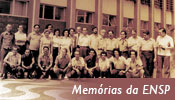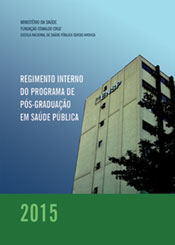- Escola Nacional de Saúde Pública Sergio Arouca
- atalho para o conteúdo desta página
Perfil - Documentos
Documentos
Assessment of biological components associated with sleepiness in young working college students
The aim of this study was to evaluate the association
between clock genes VNTR and sleep duration, chronotype and
melatonin secretion. Methods: A hundred forty-six students filled
a questionnaire about their sleep habits to determine individual preferences. Salivary samples were also collected for DNA extraction.
PER3 VNTR was genotyped using PCR. Results: Seventy subjects
were PER34/4 (47.9%), 61 PER34/5 (41.8%) and 15 PER35/5
(10.3%). When exposed to bright light at 19:00h, the
students¿ sleepiness growth went as expected. But, when exposed
at 21:00h, sleepiness slightly increased for the intermediates and
decreased at 22:00h for the evening-type students. Analyzing PER3
and HIOMT genotypes a specific haplotype, associated to melatonin
levels at 19:00h and after bright light exposure, at 19:20h, was
detected. Conclusion: With no social restrictions for sleep onset/
outset, chronotypes express different sleep preferences, partly associated
to PER3 VNTR genotype.
Visualizar:
ARQUIVO
Conhecimentos e práticas de adolescentes na prevenção de acidentes de trabalho: estudo qualitativo
OBJECTIVE: To describe knowledge and practices adopted by high school students to prevent occupational injuries. STUDY DESIGN: The study was carried out in a public school located in São Paulo, in 2003. Fifty-three evening students aged 14 to 21 years old participated the study, they were divided into two groups with and without job experience (32 and 21 students, respectively). The students answered two questions: Why do occupational injuries occur? and How do you avoid occupational injuries? Analyses were performed using the software Quali-quanti to structure collective discourses.
Visualizar:
ARQUIVO
Sleep deprevation of working adolescents - a hidden work hazard
Adolescents must wake up very early in the day contributing to their chronic sleep deprivation during weekdays. The limit for sleep may cause poor attentiveness during classes and the feeling of fatigue and thereby hinder performance of working high school students. The correlation existing between work, school, sleep deprivation, and daytime sleepiness is an issue that should be addressed by authorities. The results presented in association with the slow process for eradicating children&8217;s work, coupled with the lack of protection for working, attention should be directed towards adolescents and the negative effects of sleep debts and sleepiness. As millions of young workers enter the labor force each year, sleep issues should be addressed forcefully by researchers, educators, and governmental representatives. Such action would further the reduction of sleepiness during classes and work and the prevention of work injuries and other negative consequences of lack of sleep.
Visualizar:
ARQUIVO
Crescimento e trabalho de estudantes de ensino fundamental e médio em São Paulo, Brasil
Objective: To assess risk factors for low height and students and working adolescents in citiesof State of São Paulo, Brazil.
Methods: A stratified sample , consisting of 50.0% of students 5th grade to last year of high school, of State of São Paulo, Brazil, in 1999, was drawn two largest schools of two different cities). A total of 756 individuals were studied. The height/age indicator, according to the 1977-NCHS (National Center for Health Statistics) standards, defined malnutrition. Multivariate analyses were carried out .
Results: Low height was twice as likely in students aged 14-17 years. For those aged 17-19 years, low height was three times as likely. Being unemployed increases the risk for low-height (OR.=2.86) when compared to working adolescents. Also, low height is higher (OR.=1.81) among part-time workers.
Conclusion: Economical determinants contribute to the risks for chronic malnutrition among students, since these adolescents rely on work to live on.
Visualizar:
ARQUIVO
Efeitos do trabalho sobre a saúde de adolescentes
This study evaluated life and work conditions and their impact on the health and psychological development of adolescents. A number of 354 high school students, studying during evening period took part in this study. Data were collected using free evocation technique and questionnaires. Data were analyzed with software EVOC 2000 and SPSS. Differences were found among worker students who reported shorter mean sleep durations and: males, feeling sleepy at work and classes, referring to tougher psychological demands at work, working as salesperson, earning more than 1 minimum monthly wage, working more than 6 hours per day or 20 hours per week, working in noisy environment or polluted with gases and vapors. The representation of work among teen workers point a contradiction between recognizing work as a moral positive value to psychosocial development and identity construction, and the negative consequences due to precocious exposure to physical and psychological workloads.
Visualizar:
ARQUIVO
Occupational accidents among middle and high school students of the state of São Paulo, Brazil
Objectives: To estimate the prevalence of occupational injuries and identify their risk factors among students in two municipalities.
Methods: A stratified probabilistic sample was drawn public middle and high schools of two municipalities of São Paulo, Brazil.. A total of 781 students participated in the study and answered a comprehensive questionnaire. Multiple logistic regression models were fitted to estimate risk factors of previous and present occupational injuries.
Results: Of 781 students, 604 previously had or currently have jobs and 47% reported previous injuries. Among current workers (n=555), 38% reported injuries on their current job. Risk factors for work injuries (OR >2.0) included attending evening school, working as a housekeeper, waiter or brickmaker, and with potentially dangerous machines.
Conclusions: The study results reinforce the need of restricting adolescent work and support communities to implement social promotion programs.
Visualizar:
ARQUIVO
Factors associated with depression symptoms in high school students in São Paulo, Brazil
OBJECTIVE: To assess factors associated with depression symptoms in high school students.
METHODS: A cross-sectional study involving high school students was conducted in the city of São Paulo, Brazil, 2001. A total of 724 students aged 14&8211;18 years answered questionnaires on life and working conditions. Factors associated to depressive disorders were analyzed using multiple logistic regression controlled for occupational status.
RESULTS: Overall prevalence rate of depression was 7.5%. Rates according to gender were 39 (10.3%) in females and 15 (4.3%) in males. The multiple logistic regression analysis showed that factors associated with depressive disorders were: poor self-perception of health (OR=5.78), being female (OR = 2.45), and alcohol consumption (OR=2.35).
CONCLUSIONS: These findings suggest that it is important to have mental health professionals available in high schools for early detection of mental conditions and student counseling.
Visualizar:
ARQUIVO
Futuro e liberdade: o trabalho e a instituição escolar nas representações sociais de adolescentes
Este estudo objetivou a análise das relações estabelecidas entre o trabalho do adolescente e o processo de escolarização, em duas cidades de São Paulo, apoiado na teoria das representações sociais. Foram
pesquisados 778 adolescentes, trabalhadores e não trabalhadores, com idades entre 11 e 18 anos, que freqüentavam as escolas públicas das localidades, no período de 1998 a 2000. Foram realizados 18 grupos focais e a coleta de evocações livres. Foi utilizado o software ALCESTE 4.5; as evocações livres foram analisadas a partir da teoria do núcleo central.
Os resultados indicam que a relação trabalho-escola está estruturada numa relação de contradição entre as dimensões moral, de saber e das conseqüências do trabalho, permeadas pela possibilidade e pela impossibilidade de futuro. Como conclusão observou-se que, apesar do trabalho representar um risco para a escolarização, este é legitimado pelas representações dos próprios jovens, ora justificando-o, ora legitimando-o.
Visualizar:
ARQUIVO
Job control, job demands, social support at work and health among adolescent workers
Objective: To evaluate physical and psychological dimensions of adolescent labor and their relation to reported body pain, work injuries, sleep duration and daily working hours.
Methods: A total of 354 adolescents attending evening classes at a public school in São Paulo, Brazil, answered questionnaires regarding their living and working conditions and their health status. Multiple logistic regression analysis was used to determine relations among variables.
Results: Psychological job demands were related to body pain (OR=3.3), higher risk of work injuries (OR=3.0) and reduced sleep duration in weekdays (p<0.01). Lower decision authority in the workplace (p=0.03) and higher job security (p=0.02) were related to longer daily working hours.
Conclusions: It was concluded that besides physical stressors, psychological factors are to be taken into account when studying adolescent working conditions, as they may be associated with negative job conditions and health effects.
2010
Visualizar:
ARQUIVO
O trampo, a saúde, o futuro - livro do professor
Este livro tem o propósito de oferecer sugestões de atividades didáticas que facilitem a exploração dos temas abordados em O Trampo, a Saúde, o Futuro..., estimulando os professores a conduzirem um projeto interdisciplinar sobre o Combate ao Trabalho Infantil e a Proteção dos Trabalhadores Adolescentes.
A partir de seu ponto de vista privilegiado, e de sua profunda relevância como atores sociais, os professores certamente ajudarão a lançar luz sobre a necessidade de erradicar o sofrimento e o desrespeito aos direitos das crianças e adolescentes brasileiros precocemente inseridos no mercado de trabalho.
Visualizar:
ARQUIVO
O trampo, a saúde, o futuro
Este livro fala de assuntos que interessam a um grande número de adolescentes brasileiros &8211; os que trabalham, os que já trabalharam e estão desempregados, e os que planejam começar a trabalhar. Em linguagem de fácil compreensão, traz um resumo dos resultados de
pesquisas científicas sobre os problemas que o trabalho pode representar para a saúde, o bem-estar e o futuro dos adolescentes.
Traz também informações sobre os direitos dos jovens em relação ao trabalho e aponta alguns caminhos para melhorar sua qualidade de vida. Com esta iniciativa, a equipe de pesquisadores pretende contribuir para uma maior conscientização quanto à necessidade de programas de preparação para o trabalho, de proteção ao trabalho e de promoção da
saúde voltados para estudantes do ensino fundamental e médio, como forma de reduzir a sua vulnerabilidade e aumentar as chances de sua efetiva inclusão na sociedade.
Visualizar:
ARQUIVO
Rua Leopoldo Bulhões, 1480 - Manguinhos, Rio de Janeiro. CEP: 21041-210 - Tel: (21) 2598-2525
Este portal é regido pela Política de Acesso Aberto ao Conhecimento,
que busca garantir à sociedade o acesso gratuito, público e aberto ao conteúdo integral de toda obra intelectual produzida pela Fiocruz.

O conteúdo deste portal pode ser utilizado para todos os fins não comerciais, respeitados e reservados os direitos morais dos autores.


















